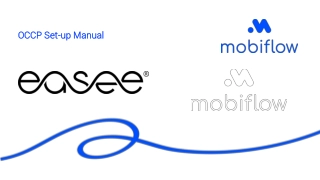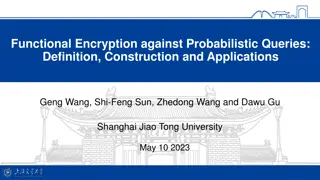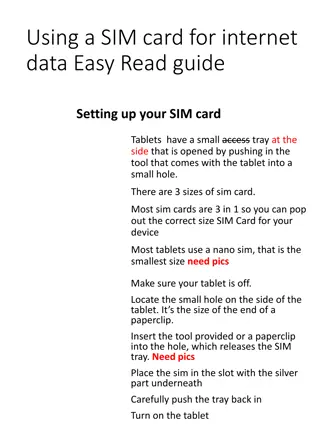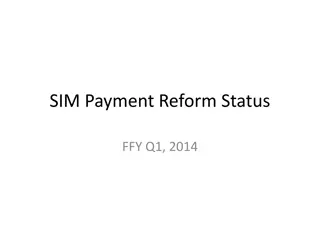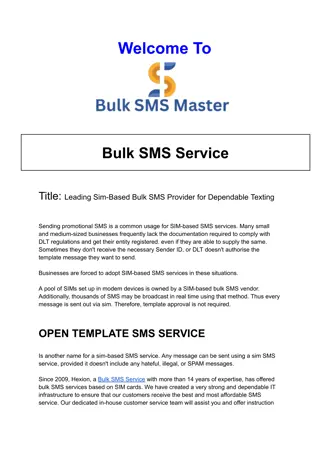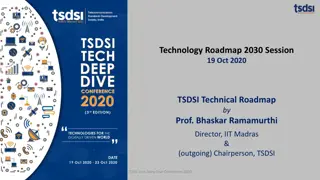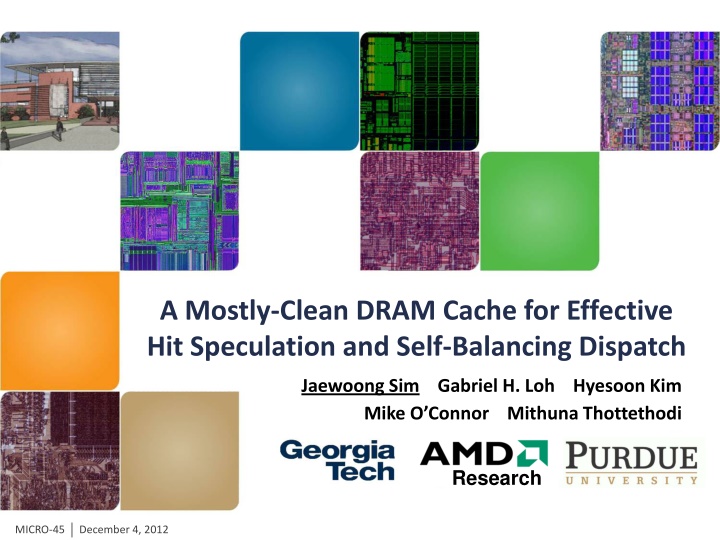
Effective DRAM Cache Optimization Strategies Explained
Discover innovative techniques for optimizing DRAM cache efficiency with a focus on Hit Speculation, Self-Balancing Dispatch, and Overhead Reduction. Explore the challenges of Dirty Data, the benefits of Die-Stacked DRAM technology, and the latest advancements in DRAM Cache state-of-the-art solutions.
Download Presentation

Please find below an Image/Link to download the presentation.
The content on the website is provided AS IS for your information and personal use only. It may not be sold, licensed, or shared on other websites without obtaining consent from the author. If you encounter any issues during the download, it is possible that the publisher has removed the file from their server.
You are allowed to download the files provided on this website for personal or commercial use, subject to the condition that they are used lawfully. All files are the property of their respective owners.
The content on the website is provided AS IS for your information and personal use only. It may not be sold, licensed, or shared on other websites without obtaining consent from the author.
E N D
Presentation Transcript
A Mostly-Clean DRAM Cache for Effective Hit Speculation and Self-Balancing Dispatch Jaewoong Sim Gabriel H. Loh Hyesoon Kim Mike O Connor Mithuna Thottethodi Research MICRO-45 December 4, 2012
Outline 2/23 2 | Motivation & Key Ideas Overkill of MissMap (HMP) Under-utilized Aggregate Bandwidth (SBD) Obstacles Imposed by Dirty Data (DiRT) | Mechanism Design | Experimental Results | Conclusion MICRO-45 December 4, 2012
Die-Stacked DRAM 3/23 3 | Die-stacking technology is NOW! Same Tech/Logic (DRAM Stack) Hundreds of MBs On-Chip Stacked DRAM!! Through-Silicon Via (TSV) Processor Die Credit: IBM | Q: How to use of stacked DRAM? This work is about the DRAM cache usage! | Two main usages Usage 1: Use it as main memory Usage 2: Use it as a large cache (DRAM cache) MICRO-45 December 4, 2012
DRAM Cache: State of the Art 4/23 4 | DRAM Cache Organization: Loh and Hill [MICRO 11] 1st Innovation: TAG and DATA blocks are placed in the same row Accessing both without closing/opening another row => Reduce Hit Latency 2nd Innovation: Keep track of cache blocks installed in the DRAM$ (MissMap) However, still has some inefficiencies! Avoiding DRAM$ access on a miss request => Reduce Miss Latency 29 data blocks 3 tag blocks Row Decoder Tags are embedded!! Row X DRAM (2KB ROW, 32 blocks for 64B line) Not Found! Do not access DRAM$ Record the existence of the cacheline! Found! Send to DRAM$ Memory Request Sense Amplifier Check MissMap for every request DRAM Bank On a hit, we can get the data from the row buffer! MissMap MICRO-45 December 4, 2012
Problem (1): MissMap Overhead 5/23 5 | MissMap is expensive due to precise tracking Size: 4MB for 1GB DRAM$ Where to architect this? MissMap Added to every memory request! Latency: 20+ cycles Miss Latency (original) ACT CAS TAG Off-Chip Memory Miss Latency (MissMap) MissMap Off-Chip Memory 20+ cycles Reduced! 20+ cycles Hit Latency (original) ACT CAS TAG DATA Increased! Hit Latency (MissMap) MissMap ACT CAS TAG DATA MICRO-45 December 4, 2012
Problem (1): MissMap Overhead 6/23 | Avoiding the DRAM cache access on a miss is necessary Question: How to provide such benefit at low-cost? | Possible Solution: Use Hit-Miss Predictor (HMP) Less Size | Cases of imprecise tracking False Positive: Prediction: Hit, Actual: Miss (this is OK) False Negative: Prediction: Miss, Actual: Hit (problem) Dirty Data | Observation: DRAM tags are always checked at installation time on a DRAM cache miss False negative can be identified, but Must wait for the verification of predicted miss requests! | HMP would be a more nice solution by solving dirty data issue! MICRO-45 December 4, 2012
Problem (2): Under-utilized BW 7/23 7 | DRAM caches SRAM caches Latency: DRAM caches >> SRAM caches Throughput: DRAM caches << SRAM caches | Hit requests often come in bursts SRAM caches: Makes sense to send all the hit requests to the cache DRAM caches: Off-chip memory can sometimes serve the hit requests faster Always send hit requests to DRAM$? Req. Buffer Stacked DRAM$ Another Hit Requests Req. Buffer Off-chip Memory Off-chip BW would be under-utilized! MICRO-45 December 4, 2012
Problem (2): Under-utilized BW 8/23 | Some hit requests are also better to be sent to off-chip memory This is not the case in SRAM caches! | Possible Solution: Dispatch hit requests to the shorter latency memory source Seems to be a simple problem We call it Self-Balancing Dispatch (SBD) | Now, we can utilize overall system BW better Dirty Data! Wait. What if the cache has the dirty data for the request? | Solving under-utilized BW problem is critical But, SBD may not be possible due to dirty data! MICRO-45 December 4, 2012
Problem (3): Obstacles by Dirty Data 9/23 9 | Dirty data restrict the effectiveness of HMP and SBD Question: How to guarantee the non-existence of dirty blocks? But, we cannot simply use WT policy! Observation: Dirty data == byproduct of write-back policy | Key Idea: Make use of write policy to deal with dirty data For many applications, very few pages are write-intensive Clean or Dirty? # of writes 2 0 0 9 0 8 1 0 4KB regions (pages) | Solution: Maintain a mostly-clean DRAM$ via region-based WT/WB policy Dirty Region Tracker (DiRT) keeps track of WB pages Clean!! Write-Back 2 0 0 9 0 8 1 0 Write-Through 4KB regions (pages) MICRO-45 December 4, 2012
Summary of Solutions 10/23 10 | Problem 1 (Costly MissMap) Hit-Miss Predictor (HMP) Mechanism START DiRT HMP SBD Eliminating MissMap + Look-up latency for every request YES Dirty Request? DRAM$ Queue | Problem 2 (Under-utilized BW) Self-Balancing Dispatch (SBD) NO YES Dispatch hit request to the shorter latency memory source E(DRAM$) < E(DRAM) YES Predicted Hit? | Problem 3 (Dirty Data) Dirty Region Tracker (DiRT) NO NO Help identify whether dirty cache line exists for a request These are nicely working together! DRAM Queue E(X): Expected Latency of X MICRO-45 December 4, 2012
Outline 11/23 11 | Motivation & Key Ideas | Design Hit-Miss Predictor (HMP) Self-Balancing Dispatch (SBD) Dirty Region Tracker (DiRT) | Experimental Results | Conclusion MICRO-45 December 4, 2012
Hit-Miss Predictor (HMP) 12/23 12 | Goal: Replace MissMap with lightweight structure 1) Practical Size, 2) Reduce Access Latency High Prediction Accuracy! | Challenges for hit miss prediction Global hit/miss history for memory requests is typically not useful PC information is typically not available in L3 | Our HMP is designed to input only memory address | Question: How to provide good accuracy with memory information? | Key Idea 1: Page (segment)-level tracking & prediction Within a page, hit/miss phases are distinct MICRO-45 December 4, 2012
HMPregion: Region-Based HMP 13/23 13 Miss Phase Hit Hit Miss Phase Phase Phase #Lines installed in the 80 cache for a 4KB page Increasing on misses 60 40 Flat on hits 20 0 85 15 22 29 36 43 50 57 64 71 78 92 99 1 8 176 106 113 120 127 134 141 148 A page from leslie3d in WL-6 155 162 169 183 190 197 204 #Accesses to the page | Two-bit bimodal predictor per 4KB region A lot smaller than MissMap (512KB vs 4MB for 8GB physical memory) Can we further optimize the predictor? Needs a few cycles to access HMP A single predictor for regions larger than 4KB | Key Idea 2: Use Multi-Granular regions Hit-miss patterns remain fairly stable across adjacent pages MICRO-45 December 4, 2012
HMPMG: Multi-Granular HMP 14/23 14 | FINAL DESIGN: Structurally inspired by TAGE predictor (Seznec and Michaud [JILP 06]) 95+% prediction accuracy with less-than-1KB structure!! Base Predictor: default predictions Tagged Predictors: predictions on tag matching Next-level predictor overrides the results of previous-level predictors Use prediction result from 3rd-level table! Base: 4MB 2nd-Level: 256KB 3rd-Level: 4KB Tracking Regions Operation details can be found in the paper! MICRO-45 December 4, 2012
Self-Balancing Dispatch (SBD) 15/23 15 | IDEA: Steering hit requests to off-chip memory Based on the expected latency of DRAM and DRAM$ | How to compute expected latency? N: # of requests waiting for the same bank L: Typical latency of one memory request (excluding queuing delays) Expected Latency (E) = N * L | Steering Decision E(off-chip) < E(DRAM_Cache): Send to off-chip memory Simple but effective!! E(off-chip) >= E(DRAM_Cache) : Send to DRAM cache MICRO-45 December 4, 2012
Dirty Region Tracker (DiRT) 16/23 16 | IDEA: Region-based WT/WB operation (dirty data) WB: write-intensive regions. WT: others | DiRT consists of two hardware structures Counting Bloom Filter: Identifying write-intensive pages Dirty List: Keep track of write-back-operated pages Write Request Hash A Hash B Hash C Pages captured in Dirty List are operated with WB! WB Pages #writes > threshold TAG NRU Dirty List Counting Bloom Filters MICRO-45 December 4, 2012
Outline 17/23 17 | Motivation & Key Ideas | Design | Experimental Results Methodology Performance Effectiveness of DiRT | Conclusion MICRO-45 December 4, 2012
Evaluations - Methodology 18/23 18 System Parameters Workloads CPU Mix Workloads Core L1 Cache L2 Cache 4 cores, 3.2GHz OOO 32KB I$ (4-way), 32KB D$(4-way) 16-way, shared 4MB WL-1 4 x mcf WL-2 4 x lbm Stacked DRAM Cache WL-3 4 x leslie3d Cache Size Bus Frequency 128 MB 1.0 GHz (DDR 2.0GHz), 128 bits per channel 4/1/8, 2048 bytes row buffer WL-4 mcf-lbm-milc-libquantum WL-5 mcf-lbm-libquantum-leslie3d Chans/Ranks/Banks WL-6 libquantum-mcf-milc-leslie3d Off-chip DRAM WL-7 mcf-milc-wrf-soplex Bus Frequency 800 MHz (DDR 1.6GHz), 64 bits per channel 2/1/8, 16KB bytes row buffer 11-11-11 WL-8 milc-leslie3d-GemsFDTD-astar Chans/Ranks/Banks tCAS-tRCD-tRP WL-9 libquantum-bwaves-wrf-astar WL-10 bwaves-wrf-soplex-GemsFDTD MICRO-45 December 4, 2012
Evaluations - Performance Need verification for predicted miss requests 19/23 19 1.6 MM HMP HMP + DiRT HMP + DiRT + SBD 20.3% improvement over baseline 15.4% more over MM does not work well! 1.5 With DiRT support, HMP becomes very effective!! Speedup over no HMP is worse than MM for many WLs 1.4 HMP without DiRT DRAM cache 1.3 1.2 1.1 1.0 Not better than the baseline MM improves AVG performance 0.9 0.8 MICRO-45 December 4, 2012
Evaluations - Effectiveness of DiRT 20/23 CLEAN: Safe to apply HMP/SBD 100% 80% 60% 40% DiRT CLEAN 20% 0% WL-1 WL-2 WL-3 WL-4 WL-5 WL-6 WL-7 WL-8 WL-9 WL-10 WT traffic >> WB traffic DiRT traffic ~ WB traffic Percentage of writebacks 100% DiRT WB WT 80% 60% to DRAM 40% 20% 0% WL-1 WL-2 WL-3 WL-4 WL-5 WL-6 WL-7 WL-8 WL-9 WL-10 MICRO-45 December 4, 2012
Outline 21/23 21 | Motivation & Key Ideas | Design | Experimental Results | Conclusion MICRO-45 December 4, 2012
Conclusion 22/23 22 | Problem: Inefficiencies in current DRAM cache approach Multi-MB/High-latency cache line tracking structure (MissMap) Under-utilized aggregate system bandwidth IDEA: Region-Based Prediction! + TAGE Predictor-like Structure! | Solution: Speculative approaches Replace MissMap with a less-than-1KB Hit-Miss Predictor (HMP) Dynamically steer hit requests either to DRAM$ or off-chip DRAM (SBD) Maintain a mostly-clean DRAM cache with Dirty Region Tracker (DiRT) IDEA: Hybrid Region-Based WT/WB policy for DRAM$! | Result: Make DRAM cache approach more practical 20.3% faster than no DRAM cache (15.4% over the state-of-the-art) Removed 4MB storage requirement (so, much more practical) MICRO-45 December 4, 2012
Q/A 23/23 23 Thank you! MICRO-45 December 4, 2012

